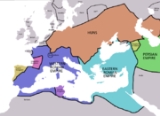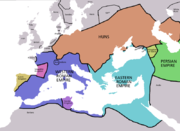
450
Encyclopedia

Common year starting on Sunday
This is the calendar for any common year starting on Sunday, January 1 or for any year in which “Doomsday” is Tuesday. Examples: Gregorian years 1989, 1995, 2006, 2017 and 2023or Julian year 1917...
(link will display the full calendar) of the Julian calendar
Julian calendar
The Julian calendar began in 45 BC as a reform of the Roman calendar by Julius Caesar. It was chosen after consultation with the astronomer Sosigenes of Alexandria and was probably designed to approximate the tropical year .The Julian calendar has a regular year of 365 days divided into 12 months...
. At the time, it was known as the Year of the Consulship of Valentinianus and Avienus (or, less frequently, year 1203 Ab urbe condita
Ab urbe condita
Ab urbe condita is Latin for "from the founding of the City ", traditionally set in 753 BC. AUC is a year-numbering system used by some ancient Roman historians to identify particular Roman years...
). The denomination 450 for this year has been used since the early medieval period, when the Anno Domini
Anno Domini
and Before Christ are designations used to label or number years used with the Julian and Gregorian calendars....
calendar era
Calendar era
A calendar era is the year numbering system used by a calendar. For example, the Gregorian calendar numbers its years in the Western Christian era . The instant, date, or year from which time is marked is called the epoch of the era...
became the prevalent method in Europe for naming years.
Eastern Roman Empire
- August 25 – MarcianMarcianMarcian was Byzantine Emperor from 450 to 457. Marcian's rule marked a recovery of the Eastern Empire, which the Emperor protected from external menaces and reformed economically and financially...
is crowned Eastern Roman Emperor.
Europe
- AnglesAnglesThe Angles is a modern English term for a Germanic people who took their name from the ancestral cultural region of Angeln, a district located in Schleswig-Holstein, Germany...
, SaxonsSaxonsThe Saxons were a confederation of Germanic tribes originating on the North German plain. The Saxons earliest known area of settlement is Northern Albingia, an area approximately that of modern Holstein...
and JutesJutesThe Jutes, Iuti, or Iutæ were a Germanic people who, according to Bede, were one of the three most powerful Germanic peoples of their time, the other two being the Saxons and the Angles...
invade BritainGreat BritainGreat Britain or Britain is an island situated to the northwest of Continental Europe. It is the ninth largest island in the world, and the largest European island, as well as the largest of the British Isles...
(traditional date), marking the beginning of the usage period of Old English. - Dome of Baptistry of NeonBaptistry of NeonThe Baptistry of Neon is a religious building in Ravenna, central Italy. The most ancient monument remaining in the city, it was partly erected on the site of a Roman bath...
, RavennaRavennaRavenna is the capital city of the Province of Ravenna in the Emilia-Romagna region of Italy and the second largest comune in Italy by land area, although, at , it is little more than half the size of the largest comune, Rome...
, ItalyItalyItaly , officially the Italian Republic languages]] under the European Charter for Regional or Minority Languages. In each of these, Italy's official name is as follows:;;;;;;;;), is a unitary parliamentary republic in South-Central Europe. To the north it borders France, Switzerland, Austria and...
, is started to be remodeled (approximate date).
Deaths
- July 28 – Theodosius IITheodosius IITheodosius II , commonly surnamed Theodosius the Younger, or Theodosius the Calligrapher, was Byzantine Emperor from 408 to 450. He is mostly known for promulgating the Theodosian law code, and for the construction of the Theodosian Walls of Constantinople...
, East Roman Emperor (after falling from his horse while hunting) - November 27 – Galla PlacidiaGalla PlacidiaAelia Galla Placidia , daughter of the Roman Emperor Theodosius I, was the Regent for Emperor Valentinian III from 423 until his majority in 437, and a major force in Roman politics for most of her life...
- December 2 – Peter ChrysologusPeter ChrysologusPeter Chrysologus was Bishop of Ravenna from about AD 433 until his death. He is revered as a saint by the Roman Catholic Church and was declared a Doctor of the Church by Pope Benedict XIII in 1729.-Life:...
, Archbishop of RavennaRavennaRavenna is the capital city of the Province of Ravenna in the Emilia-Romagna region of Italy and the second largest comune in Italy by land area, although, at , it is little more than half the size of the largest comune, Rome... - Cui HaoCui HaoCui Hao , courtesy name Boyuan , was a prime minister of the Chinese/Xianbei dynasty Northern Wei. Largely because of Cui's counsel, Emperor Taiwu of Northern Wei was able to unify northern China, ending the Sixteen Kingdoms era and, along with the southern Liu Song, entering the Southern and...
- KalidasaKalidasaKālidāsa was a renowned Classical Sanskrit writer, widely regarded as the greatest poet and dramatist in the Sanskrit language...
, author of "ShakuntalaShakuntalaIn Hindu mythology Shakuntala is the wife of Dushyanta and the mother of Emperor Bharata. Her story is told in the Mahabharata and dramatized by Kalidasa in his play Abhijñānaśākuntalam .-Etymology:Rishi Kanva found her in forest as a baby surrounded by Shakunta birds...
" - Socrates ScholasticusSocrates ScholasticusSocrates of Constantinople, also known as Socrates Scholasticus, not to be confused with the Greek philosopher Socrates, was a Greek Christian church historian, a contemporary of Sozomen and Theodoret, who used his work; he was born at Constantinople c. 380: the date of his death is unknown...
, church historian

